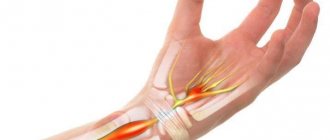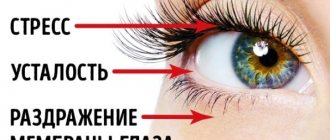The radial nerve runs along the back surface of the shoulder, as if in a spiral, and gives off branches that provide movement of the muscles responsible for extension of the forearm and hand, outward rotation of the forearm, sensitivity of the skin of the back surface of the shoulder and forearm. Among other nerves of the hand, neuritis occurs most often in it.
Our expert in this field:
Lashch Natalia Yurievna
Neurologist of the highest category, candidate of medical sciences, associate professor. Laureate of the Moscow City Prize in the field of medicine.
Call the doctor Reviews about the doctor
Why does radial neuritis occur?
This is usually caused by damage to the nerve trunk due to prolonged compression. This may be due to the following reasons:
- "Saturday Night Paralysis" . This interesting name appeared due to the fact that neuritis and other damage to the radial nerve often occur in people who like to spend their days off drinking alcohol and then fall asleep with their hand under their head or under their torso.
- "Honeymoon Paralysis" . It occurs after sleeping in an embrace, when the head of one person lies on the hand of another for a long time.
- “Crutch paralysis” occurs in some people who constantly use crutches.
- Fracture of the humerus. In this case, bone fragments can damage nerve fibers.
- Injections into the outer part of the shoulder . Most often, injury to the radial nerve occurs if it is located unusually, or if the injection is given incorrectly.
- Strongly pulling the arm with a tourniquet for a long time when trying to stop bleeding.
- Infections. A rarer reason. Neuritis can be caused by: influenza, pneumonia, typhus and some other infectious diseases.
- Poisoning, for example, alcohol, lead.
Ulnar nerve entrapment
The ulnar nerve helps control the muscles in the forearm that allow a person to hold objects. It also provides sensation to the little finger and the half of the ring finger next to the little finger on both the front and back of the hand.
The ulnar nerve is also responsible for the numbness, pain, or shock you may feel when you hit the inside of your elbow.
A pinched ulnar nerve usually occurs due to too much pressure on the elbow or wrist.
If you sleep with your arms folded inward or underneath you, you may feel numbness in:
- Your little finger and ring finger
- Part of the palm under these fingers
- The back of the hand under these fingers
Continued compression of the ulnar nerve may contribute to the development of cubital tunnel syndrome. If the numbness is accompanied by pain or weakness, make an appointment with your doctor. The doctor will recommend therapeutic exercises that need to be performed at home or prescribe wearing a radiation bandage.
Treatment of neuritis of the radial nerve of the hand
Depending on the causes of the disease, the doctor may prescribe:
- Anti-inflammatory drugs.
- Antibiotics - if the pathology is caused by an infection.
- Drugs that normalize metabolic processes in nervous tissue.
- Means for improving blood flow in small vessels that supply nerve fibers.
- In case of poisoning - intravenous infusions of solutions through a dropper to remove toxic substances.
- Physiotherapy: magnetic therapy, UHF.
If the damage to the nerve fibers is caused by injury, it is necessary to carry out timely and correct treatment: straighten the dislocation, match the fragments of the broken bone and apply a plaster cast.
For severe injuries, surgical treatment may be considered.
The prognosis is usually favorable; with timely treatment, after some time, complete restoration of impaired functions occurs. Often, after conditions such as “Saturday paralysis,” recovery occurs on its own without therapy. If the disturbances persist, it is better to see a neurologist.
For effective treatment of radial nerve neuritis, which will help restore its functions as quickly and fully as possible, contact a neurologist. Do not engage in self-diagnosis, especially if movements and sensation in the hand are severely impaired, and these disorders persist for a long time. You can make an appointment with a doctor at the Medica24 international clinic at any time of the day and any day of the week by calling +7 (495) 230-00-01.
We will call you back
Message sent!
expect a call, we will contact you shortly
Symptoms of radial neuritis depend on the level at which it is damaged:
In the armpit area and at the top of the shoulder:
- The thumb and index finger are connected.
- It is difficult to straighten the forearm and hand.
- It is difficult to rotate the forearm outward when the arm is extended.
- Sensitivity on the skin in the area of the thumb, index and middle fingers is reduced, “crawling goosebumps” and numbness occur.
In the middle of the shoulder:
- Extension of the elbow joint is not impaired.
- The sensitivity of the skin of the shoulder is preserved.
- All other symptoms that are described above for neuritis of the radial nerve in the upper part are present.
At the bottom of the shoulder and at the top of the forearm:
- The sensitivity of the skin on the back of the forearm is not impaired.
- The sensitivity of the skin on the back of the hand is reduced.
- It is difficult to straighten the hand.
Carpal tunnel syndrome: treatment and prevention
In carpal tunnel syndrome (also sometimes called carpal tunnel syndrome), pain occurs due to compression of the median nerve, which is responsible for providing sensation to several fingers.
Causes of the syndrome
Increased pressure on the median nerve can be caused by swelling or a number of other problems. As a rule, carpal tunnel syndrome is observed in the fair sex, as well as in those who, by the nature of their profession, are forced to perform monotonous flexion-extension movements of the hand (sign language interpreters, motorcycle racers, drummers, artists and representatives of other specialties). But most often this disease affects those whose work involves typing on a computer keyboard.
Hypothyroidism, rheumatoid arthritis, diabetes, pregnancy, obesity, various injuries and, oddly enough, even smoking can cause wrist pain, as it can reduce blood flow to the median nerve.
Main symptoms
It's easy to tell if you have carpal tunnel syndrome: tingling, numbness, weakness, and pain in your fingers or wrist. The index, middle and partially ring fingers are most often affected. There should be no problem with the little finger in case of carpal tunnel syndrome, since it is not connected to the median nerve.
In the initial stage of the disease, symptoms appear at night. After shaking the brush, the unpleasant sensations disappear - these are the first signs of the development of the syndrome.
Diagnosis and treatment
As soon as pain and discomfort appear, you need to seek help from a specialist. The doctor will examine you, check your health, inquire about your professional activities, and ask about possible injuries to your wrist, arm, or neck (perhaps the cause is simply a sprain). During the test, your doctor will check the sensation, strength, and appearance of your neck, shoulders, arms, wrists, and hands, and you'll also need to take a blood test to see what other issues might be causing the discomfort. To accurately diagnose carpal tunnel syndrome, the Tinel and Phalen tests are used.
Mild symptoms of the syndrome can be treated at home, and the sooner you start doing this, the higher the chances of success and prevention of nerve damage. Here are a few simple rules to follow:
- If discomfort occurs, you should stop working and give your wrist a rest;
- It is necessary to cool the wrist for a few minutes every couple of hours and take special medications to reduce pain;
- Before going to bed, you need to secure your wrist with an elastic bandage: this procedure will reduce pressure on the median nerve.
If the pain does not go away within one to two weeks, and self-treatment does not work, immediately consult a specialist. He will prescribe medication to relieve carpal tunnel syndrome or treat the problem that caused it.
Surgical treatment is also possible, but, as a rule, it is only possible if, due to pain, you cannot work or perform ordinary household manipulations, even after prolonged conservative treatment.
Prevention of carpal tunnel syndrome
To prevent carpal tunnel syndrome, you need to take care of your health. Get on the path to returning to a healthy weight by quitting smoking, exercising, and keeping conditions like arthritis and diabetes under control. In addition, follow these simple preventative tips:
- To hold objects while working, use not only your fingers, but your entire hand;
- When working at a computer, keep your hands slightly above your wrists and your shoulders relaxed;
- Change hands, performing constantly repeating movements.
Author: K.M.N., Academician of the Russian Academy of Medical Sciences M.A. Bobyr
How to identify symptoms of radial neuritis?
There are some simple tests that help detect characteristic signs of the disease:
- Stand up, lower your arms along your body so that they are in an extended state. Try turning your forearms outward so that your palms “look” forward. In this case, you will have difficulties.
- Place your hands on the table so that your palms are on top. Try moving your thumbs to the sides. This will create difficulties.
- Place your hands on the table with your palms facing down. Try lifting your middle finger and placing it on top of your index or ring finger. This will not be possible.
- Place your hands together with your palms facing each other. Try spreading your fingers out to the sides. In this case, the fingers on the sore hand will not move to the side, but, on the contrary, will bend and slide along the healthy one.
- Stand up and raise your arms forward. In this case, the hand on the sore side will hang down.
If you find yourself with similar symptoms of radial neuritis, and they do not go away long enough, contact a neurologist at the clinic.
Types of neuritis
A distinction is made between local neuritis and polyneuritis.
Local neuritis
is an inflammation of any one nerve (facial, auditory, oculomotor, glossopharyngeal, radial, sciatic, peroneal, femoral, etc.).
Polyneuritis
is multiple inflammation of the nerves. If the effect of the factor that caused the inflammation is local, only one nerve is affected. Polyneuritis develops under the influence of a systemic factor, which, as a rule, leads to degeneration of the nerve sheath and nerve fibers.
How is the diagnosis made?
Most often, a doctor diagnoses the disease by assessing the symptoms of radial neuritis during a neurological examination. In some cases, additional tests and studies and consultations with other specialists may be required.
Only a neurologist can correctly assess the symptoms and prescribe treatment. Therefore, you should not engage in self-diagnosis. Visit a specialist: you can make an appointment with a neurologist at the international clinic Medica24 by calling +7 (495) 230-00-01
The material was prepared by Natalya Yurievna, a neurologist at the international clinic Medica24, Candidate of Medical Sciences Lasch.
Possible causes: from common to rare
Why does my hand hurt? Doctors consider several groups of diseases that manifest as pain:
- injuries (sprains, ligament tears, fractures, bruises);
- inflammation;
- great physical activity;
- diseases of the cardiovascular system;
- nerve problems;
- diseases of the musculoskeletal system.
It is known that if discomfort is felt in the left arm, then this is a serious harbinger of a heart attack, so it cannot be ignored. Additional symptoms here are shortness of breath, fear of death, cold sweat, nausea. If you have joint pain, you should also not delay consulting a specialist, because many diseases of the joints lead to disability.







